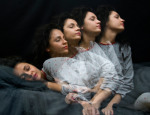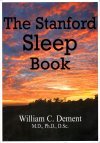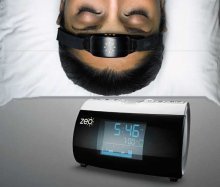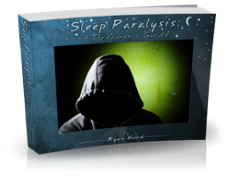
| Connect & Subscribe |
The Various Types Of Sleep Disorders
Written by Kevin Morton, with medical descriptions from The Stanford Sleep BookThere are currently over 80 different types of sleep disorders listed in the International Classification of Sleep Disorders (or ICSD), the latest edition of which was published in 2005.
This is fantastic evidence of how far we've come in the field of sleep medicine in the last handful of decades; however, the fact that an enormous number of people who actually have these various types of sleep disorders are not diagnosed and live without treatment goes to show how very far we still have left to go.
Sleep medicine hasn't yet permeated the medical school curriculum to any significant degree, so there's a large discrepancy between the knowledge that exists about sleep medicine and what most general physicians know about it. As a result, many types of sleep disorders go undiagnosed, mistaken for other ailments whose symptoms may be caused by the sleep disorder.
This highlights the important role that sleep specialists play in society's overall health, but also the extraordinary importance of widespread public knowledge about the types of sleep disorders and their symptoms. If you know how certain sleep disorders make themselves apparent and affect waking life, you will be well-equipped to catch them in yourself and your loved ones.
Dr. D's Sleep Book Says...
The fact that most doctors know very little about sleep disorders today poses a serious threat to many individuals who already have, or will soon develop, a sleep disorder. Everyone is almost certain to experience one or more sleep disorders in their lifetime. If the current situation does not change, the majority of our citizens who are suffering from sleep disorders will remain undiagnosed and untreated.
Everyone knows that pain and fever are likely to be associated with a medical problem. It is crucial that everyone also know and recognize the symptoms that are caused by specific and often very serious sleep disorders so that appropriate actions can be taken.
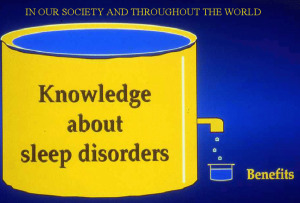 The knowledge we have about sleep disorders has only trickled into benefits. We can open up the floodgates by creating more awareness.
The knowledge we have about sleep disorders has only trickled into benefits. We can open up the floodgates by creating more awareness.
What Dr. Dement highlights above really goes to show that the general public, you and me, would be doing themselves a great favor if they didn't have to be dependent solely on doctors when it comes to sleep health. Sleep medicine is still working its way into the field. So in the meantime, if we educate ourselves we can avoid the debilitating and sometimes fatal consequences of sleep disorders, being ready to consult a sleep specialist when the need arises.
That said, let's get started!
Sleep disorders can be categorized into two main categories--dyssomnias and parasomnias. (There is also a third tangential category that relates to other conditions, such as depression and alcoholism, and we'll cover this below as well.)
Dyssomnias
Dyssomnias are disorders that produce either excessive sleepiness or difficulty in initiating or maintaing sleep. Some of the most common dyssomnias include obstructive sleep apnea, restless legs syndrome, and conditions of the biological clock such as shift work sleep disorder, and delayed sleep phase syndrome.
Dyssomnias can additionally be divided up into three sub-categories: Intrinsic Sleep Disorders, Extrinsic Sleep Disorders, and Circadian Rhythm Sleep Disorders. Let's look below to see how the various types of sleep disorders fit in.
A. Intrinsic Sleep Disorders
- Psychophysiological Insomnia
- Sleep State Misperception
- Idiopathic Insomnia - Basically a lifelong inability to obtain adequate sleep, presumably due to an abnormality of the neurological control of the sleep-wake system.
- Narcolepsy
- Recurrent Hypersomnia - This rare condition is characterized by repeated episodes of too much sleep, typically weeks or months apart. The best known form is Kleine-Levin syndrome (more colloquially known as the Sleeping Beauty syndrome).
- Idiopathic Hypersomnia
- Posttraumatic Hypersomnia
- Obstructive Sleep Apnea Syndrome
- Central Sleep Apnea Syndrome
- Central Alveolar Hypoventilation Syndrome
- Periodic Limb Movement Disorder
- Restless Legs Syndrome
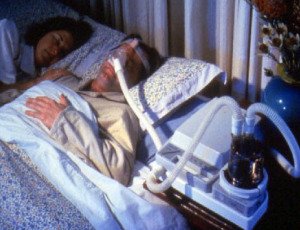 One of the most common and dangerous dyssomnias, obstructive sleep apnea, is treated using this continuous positive airway pressure (or CPAP) machine.
One of the most common and dangerous dyssomnias, obstructive sleep apnea, is treated using this continuous positive airway pressure (or CPAP) machine.
B. Extrinsic Sleep Disorders
- Inadequate Sleep Hygiene
- Environmental Sleep Disorder
- Altitude Insomnia
- Adjustment Sleep Disorder
- Insufficient Sleep Disorder
- Limit-Setting Sleep Disorder - Primarily a childhood issue, limit-setting sleep disorder is characterized by the inadequate enforcement of bedtimes by a caretaker with the patient then stalling or refusing to go to bed at a time conducive to good health.
- Sleep-Onset Association Disorder
- Food Allergy Insomnia
- Nocturnal Eating (Drinking) Syndrome
- Hypnotic-Dependent Sleep Disorder
- Stimulant-Dependent Sleep Disorder
- Alcohol-Dependent Sleep Disorder
- Toxin-Induced Sleep Disorder
C. Circadian Rhythm Sleep Disorders
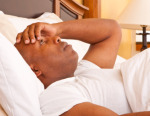 Circadian rhythm sleep disorders make it hard to fall asleep when you want to.
Circadian rhythm sleep disorders make it hard to fall asleep when you want to.
- Time Zone Change (Jet Lag) Syndrome
- Shift Work Sleep Disorder
- Irregular Sleep-Wake Pattern
- Delayed Sleep Phase Syndrome
- Advanced Sleep Phase Syndrome
- Non-24-Hour Sleep-Wake Disorder
Note: Much of the medical descriptions contained on this page come from The Stanford Sleep Book.
An Overview of Sleep Disorders
Before we move on to parasomnias, do you want to dig a little deeper into the different types of sleep disorders from a visual perspective?
Getting enough sleep is vital for mental and physical health, but sleep disorders often prevent this health from being achieved. This video, hosted by Jane Hanson and featuring Dr. James Wyatt among others, delves into how this disruption occurs and what that means for you and society at large. It also gives an overview of some of the most common sleep disorders.
Parasomnias (Learn more about parasomnias)
Unlike dyssomnias, parasomnias are clinical disorders that are not abnormalities of the processes that govern our sleep/wake states (processes such as our biological clock, for example). Instead, parasomnias consist mainly of inappropriate physical behaviors that intrude predominantly during sleep.
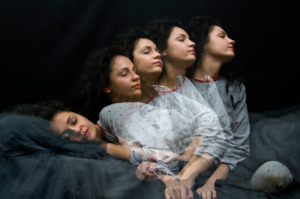 Sleepwalking is a common parasomnia.
Sleepwalking is a common parasomnia.
When you think of parasomnias, "physical" is a key word. Think of examples such as sleepwalking, sleep starts, bruxism, and bedwetting (or sleep enuresis, as it's technically called), which all involve some sort of specific action or movement. This is not an overarching rule, but just something to help you remember the majority of parasomnias by (note too that parasomnia and physical both start with the letter p). Other disturbances that encroach into sleep, such as nightmares, also fall under the category of parasomnias.
Furthermore, parasomnias can be divided up into four sub-categories: Arousal Disorders, Sleep-Wake Transition Disorders, Parasomnias Usually Associated With REM Sleep, and an "Others" category. Let's take a look at where the various types of parasomnias pan out:
A. Arousal Disorders
- Confusional Arousals
- Sleepwalking (Somnambulism)
- Sleep Terrors (Pavor Nocturnus)
Really severe arousal disorders have even been known to bring about violence during sleep, sometimes resulting in deaths and court hearings. You can learn more about sleep-related violence and the trials that follow here.
B. Sleep-Wake Transition Disorders
- Rhythmic Movement Disorder
- Sleep Starts
- Sleep Talking (Somniloquy)
- Nocturnal Leg Cramps
C. Parasomnias Usually Associated With REM Sleep
- Nightmares
- Sleep Paralysis
- Impaired Sleep-Related Penile Erections
- Sleep-Related Painful Erections
- REM Sleep-Related Sinus Arrest - A cardiac rhythm disorder that is characterized by sinus arrest (a pause in the cardiac rhythms) during REM sleep in otherwise healthy individuals. EKG monitoring demonstrates periods of asystole (a lack of contractions of the heart) during sleep that may last up to nine seconds! These periods of asystole occur repeatedly during REM sleep and as you can imagine, are very alarming and dangerous. They also are not associated with either sleep apnea nor sleep disruption.
- REM Sleep Behavior Disorder
D. Other Parasomnias
- Sleep Bruxism - Tooth grinding
- Sleep Enuresis
- Sleep-Related Abnormal Swallowing Syndrome - A disorder in which inadequate swallowing of saliva results in aspiration (inhalation) of excess saliva, with coughing, choking, and brief arousals or full awakenings from sleep.
- Nocturnal Paroxysmal Dystonia
- Sudden Unexplained Nocturnal Death Syndrome (SUND) - SUND is characterized by sudden death during sleep in healthy young adults, particularly of Southeast Asian descent. Neither clinical history nor autopsy results provide an explanation for the cause of death--it remains a mystery. According to witnesses of SUND though, the first signs are choking, gasping, and labored respiration.
- Primary Snoring
- Infant Sleep Apnea
- Congenital Central Hypoventilation Syndrome
- Sudden Infant Death Syndrome (SIDS) - SIDS is unexpected sudden death of infants in which a thorough postmortem investigation fails to demonstrate an adequate cause for death. At least 80% of SIDS deaths occur at a time when infants were assumed to be asleep. It has not been unequivocally established whether the primary cause of death is cardiac or respiratory failure.
- Benign Neonatal Sleep Myoclonus
Note: Much of the medical descriptions contained on this page come from The Stanford Sleep Book.
Sleep Disorders Associated With Medical/Psychiatric Disorders
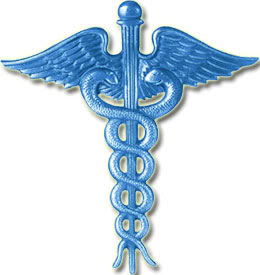
Most mental or mood disorders can have some sort of sleep disturbance that typically comes along with it to affect the patient. The ICSD includes various psychoses, mood disorders, anxiety disorders, panic disorders, and alcoholism in its list of sleep disorders because they are commonly seen in patients who present sleep complaints, and thus need to be considered to paint the full diagnosis picture.
This category of sleep disorders associated with other medical disorders is also broken up into three sub-categories: Mental Disorders, Neurological Disorders, and other Medical Disorders. The disorders that fall within each category are listed below.
A. Associated with Mental Disorders
- Psychoses
- Mood Disorders
- Anxiety Disorders
- Panic Disorders
- Alcoholism
B. Associated with Neurological Disorders
- Cerebral Degenerative Disorders
- Dementia
- Parkinsonism - Refers to a group of neurologic disorders characterized by hypokinesia, tremor, and muscular rigidity. Insomnia is the most common sleep-related symptom in patients with parkinsonism.
- Fatal Familial Insomnia - A progressive disorder that begins with difficulty in initiating sleep and leads to total lack of sleep within a few months and, later, to spontaneous lapses from quiet wakefulness into a comatose state with enacted dreams.
- Sleep-Related Epilepsy
- Electrical Status Epilepticus of Sleep
- Sleep-Related Headaches - Sleep-related cluster headaches, chronic paroxysmal hemicrania, and migraines are severe, mainly unilateral headaches that often have their onset during sleep. The patient is either awakened with pain during the night or is aware of an attack upon awakening in the morning.
C. Associated with Other Medical Disorders
- Sleeping Sickness
- Nocturnal Cardiac Ischemia
- Chronic Obstructive Pulmonary Disease (COPD) - Characterized by a chronic impairment of airflow through the respiratory tract between the atmosphere and the gas-exchange portion of the lung. Altered cardiorespiratory physiology during sleep or a complaint of insomnia can occur.
- Sleep-Related Asthma
- Sleep-Related Gastroesophageal Reflux
- Peptic Ulcer Disease
- Fibromyalgia - Characterized by diffuse musculoskeletal pain, chronic fatigue, unrefreshing sleep, and increased tenderness in specific localized anatomic regions, without laboraty evidence of contributing articular (joint), nonarticular, or metabolic disease.
What Do Sleep Disorders Do?
Do you want to dig a little deeper into the different types of sleep disorders from a visual perspective?
This video, from Dr. Gerald Chodak, does a nice job of illustrating the complexities inherent with such a large variety of ailments, and how sleep disorders can affect you. He highlights some neurological and hormonal factors at play with our circadian rhythm, physical characteristics that can lead to disorders such as sleep apnea, and you'll even get a taste of polysomnography from views in a sleep lab.
And join the conversation with your own comments here:
blog comments powered by DisqusAbout This Site
Welcome! This site is continuously being created by students of Dr. William C. Dement's Sleep And Dreams course at Stanford University.
We made this site as a call to action for people all over the world to live healthier, happier, safer, and more productive lives by learning about their own sleep. We have faith that reading the information provided on this site will motivate you to be smart about your sleep deprivation and strategic about your alertness in order to live life to your fullest, most energetic potential.
In fact, we challenge you to do so! What do you say, are you up for the challenge?
Interviews With Sleep Specialists: Insights Into the Worlds of Sleep Medicine & Sleep Business
America's Most Dangerous Disorder: What Is Sleep Apnea Doing To Your Sleep?
Sleep Debt: How Much More Will You Achieve When You Reduce Yours?
The Stages Of Sleep: The Journey Through The Night
Delayed Sleep Phase: You Want To Sleep But You're Not Tired Yet
Paralyzed at Night: Is Sleep Paralysis Normal?
Sleep In Words: Smart, Strange, and Funny Quotes About Sleep
Sleep Disorders In Children: What's Keeping Your Child From A Full Night's Rest?
Attacks of Pavor Nocturnus (a.k.a. Sleep Terrors, Night Terrors, or Incubus Attacks)
The Stanford Sleep Book
Dr. Dement's pioneering textbook has been the core text for Sleep and Dreams since 1980, but it has just recently been made available to the wider public for the first time.
In it you'll find a more detailed account of the most important things you need to know about sleep, alertness, dreams, and sleep disorders. Studies, statistics, plus plenty of Dr. Dement's classic anecdotes painting the history of sleep medicine.
Preface | Intro | Contents | Get A Copy
More Sleep Resources
The Zeo
A revolution in personal sleep tracking, the Zeo is a wireless headband that transmits your brainwaves in realtime to a dock (pictured here) or your smartphone. The result? You can wake up and see exactly what stages of sleep you were in during the night! Unprecedented personalized sleep knowledge.
Sleep Paralysis: A Dreamer's Guide
Ever woken up paralyzed? A surprising number of us have, believe it or not. But few know the actual causes of this phenomenon, and fewer still how to exert control over it. Dream researcher and sleep paralysis expert Ryan Hurd shares breakthrough insights into how to do just that.
Important Disclaimer
Please Note:
The information found on this page and throughout this site is intended for general information purposes only. While it may prove useful and empowering, it is NOT intended as a substitute for the expertise and judgments of healthcare practitioners.
For more info, see our
Terms of Use.








